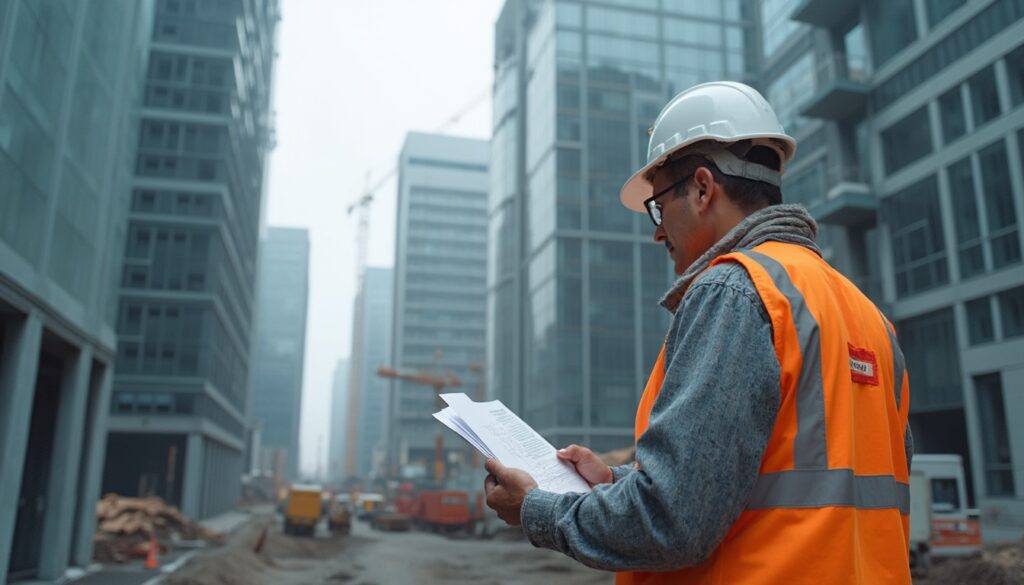The core problem: data chaos and its consequences for construction projects
On many construction sites, unstructured communication via WhatsApp is the standard, leading to an uncontrollable data chaos. Important information, photos, and instructions get lost in countless chats and later cannot be found reliably. According to an analysis, 48% of all costly rework is attributable to this poor communication and inadequate data management.
The consequences are serious: projects are delayed, budgets are exceeded by up to 20%, and the incomplete documentation poses enormous legal risks. In one examined company, for example, over 58% of all stored files were duplicates, making the search for current information incredibly difficult. This information chaos paralyzes productivity and leads to daily friction losses between the construction site and the office. The right construction software is therefore not a luxury, but a necessity.
Without a central data source, teams work with outdated plans, leading to costly construction errors that could be avoided. The lack of structure also makes it impossible to maintain a seamless construction diary that could serve as evidence in the event of disputes. These inefficient processes are a key reason why the construction industry lags behind other sectors in the digitization index with a score of 53 out of 100. Introducing a central platform is the first step toward solving these problems.
The solution: how central construction data management software increases efficiency
A construction data management software acts as a ‘single source of truth’ and ensures that all stakeholders can access the same up-to-date information at any time. By centralizing plans, reports, and all communication on one platform, misunderstandings are reduced by at least 25%. Companies report saving over 100 hours per project through optimized data management.
These systems enable a seamless digital process chain from the office to the construction site. 81% of construction companies see such cloud platforms as the greatest potential for advancing their business. Instead of manually reconciling information, data is automatically synchronized. This leads to a significant process optimization in construction and gives project managers more time for their core tasks.
The benefits of a central data platform include:
- Always up-to-date documents: Every employee is guaranteed access to the latest version of plans, reducing errors by up to 30%.
- Seamless traceability: Every change and every decision is logged and can be accessed at any time.
- Location-independent access: Teams at the construction site and in the office work with the same data in real-time.
- Reduced search times: Important documents are found in seconds, instead of being searched for in hours from emails or chats.
By consolidating the data, not only is efficiency increased, but a foundation for legally secure documentation is also established.
Automatic and legally secure documentation as standard
One of the biggest challenges is creating a complete and legally secure construction documentation. Manual construction reports are time-consuming and often incomplete. A modern construction data management software automates this process by capturing photos, notes, and events directly from the construction site via smartphone and archiving them chronologically in the correct project. This saves up to 60 minutes per construction manager daily.
In the event of a dispute, clean documentation is crucial to enforce or refute claims. The software ensures that all entries are timestamped and include a user stamp that cannot be altered. With this, you meet the requirements of the VOB and create a watertight basis for the case of legal disputes. Good digital construction documentation is thus an insurance for your company.
Digital capturing offers clear advantages over the analog method:
- Completeness: Standardized input masks ensure that all relevant information, such as weather, workforce, and services provided, is captured.
- Evidence security: Photos and documents are directly linked to the respective process and are stored tamper-proof.
- Efficiency: Reports can be created with just a few clicks and can be sent immediately to clients or partners, reducing administrative effort by over 50%.
- Transparency: All project participants have real-time insight into construction progress, greatly improving communication.
These automated processes not only reduce effort but also significantly minimize the error rate in data collection.
Seamless communication: the bridge between the construction site and the office
Communication breakdowns between the construction site and the office are one of the main causes of inefficiency. A construction data management software bridges this gap by providing a direct and structured communication platform. Instead of relying on unsecured messengers, communication occurs project-related and traceable directly within the application. This increases response speed to problems by up to 40%.
A central feature is the task management, which is directly linked to the documentation. Deficiencies can be captured by photo, assigned to a trade, and given a deadline. The entire process from reporting to completion is transparently documented. Such a mobile data collection on the construction site ensures that no task is lost.
International teams also benefit from integrated translation features that overcome language barriers with a click. An instruction in German can be instantly displayed to the subcontractor in their native language. This avoids misunderstandings that can quickly lead to costs of several thousand euros in complex construction projects. Structured communication is a crucial factor for project success.
Your advantage with Valoon: simplicity, efficiency, and legal certainty
The market for construction software in Germany is growing by around 12% annually, yet many solutions are complex and require extensive training. Valoon was specifically designed to eliminate this barrier. Our construction data management software is based on WhatsApp and therefore requires zero training effort for employees on the construction site. Acceptance within the team is at 100% from day one.
You benefit from automatic, legally secure documentation without having to completely change your usual processes. All data sent via WhatsApp – photos, videos, voice messages, and texts – are automatically legally secure archived in the correct digital construction diary. This not only saves valuable time daily but also provides the security you need for demanding projects. Switch now to a cloud software for construction, that really works.
Let’s summarize the key benefits: You increase your efficiency through automated processes, minimize risks through seamless documentation, and enhance communication across the entire team. Valoon is the straightforward solution that integrates seamlessly into your daily work. Book your free demo now and see for yourself how easy digital construction data management can be.
More Links
Wikipedia provides a comprehensive overview of construction documentation, its significance, and content.
Das Federal Statistical Office analyzes the digitization potential in construction activity statistics.
Das Fraunhofer IESE provides a blog article about a study on digitization in the construction industry.
PwC Germany analyzes the pressure on the construction industry, particularly regarding capital projects and infrastructure.
Der Main Association of German Construction Industry provides current figures and facts about the German construction industry.
BIM Germany provides comprehensive information about Building Information Modeling (BIM) in Germany.
Die Chamber of Crafts Dortmund describes a seminar on legally secure construction documentation.
Der Federal Association of Expert Council for Construction Damages provides the 2022 Update on the construction damage report.
Das Statistikportal.de provides comprehensive statistics on construction and crafts in Germany.
FAQ
Is the data storage with Valoon legally secure and GDPR compliant?
Yes, absolutely. Valoon stores all your project data on servers in Germany. Archiving is performed securely and meets all GDPR and GoBD requirements. You receive seamless and unalterable documentation that holds up as evidence in court.
Do my employees on the construction site need to install a new app?
No, and that is the key advantage of Valoon. Your teams on the construction site continue to use WhatsApp as usual. There is no need to install a new app or undergo training. All the technology runs in the background.
For which company sizes is Valoon suitable?
Valoon is suitable for construction and craft companies of any size – from small craft businesses to large general contractors. The platform is scalable and adapts flexibly to your number of projects and team size.
What costs are incurred for use on the construction site?
For employees on the construction site, using Valoon is completely free. Costs are only incurred for users in the office who manage and evaluate the data in the web dashboard. This pricing model lowers the entry barrier and ensures maximum acceptance.
Can I test Valoon for free?
Yes, we offer a free and non-binding demo in which we personally present the platform to you and answer all your questions. This way, you can see for yourself how easy and efficient construction data management with Valoon is.
How quickly is Valoon ready for use?
Valoon is typically ready for your company within 24 hours after booking. The setup is straightforward and does not require extensive IT integration. You can practically start professionalizing your construction documentation immediately.








